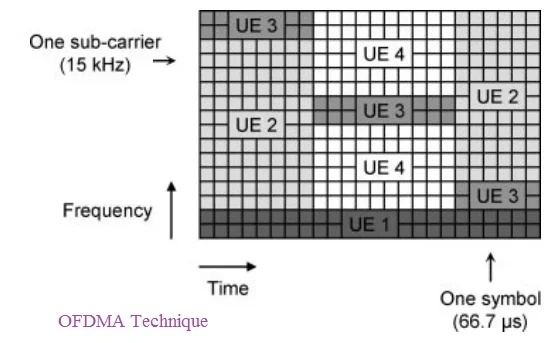16d vs 16e-difference between fixed wimax and mobile wimax
This page fixed wimax(16d) versus mobile wimax(16e) covers difference between fixed wimax(16d) and mobile wimax(16e) technologies. Refer 16e vs 16m for difference between 16e and 16m(wimax advanced) standards.
There are various versions of wimax standards viz.IEEE 802.16-2001, IEEE 802.16-2004, IEEE 802.16e-2005, IEEE 802.16-2009. IEEE 802.16-2004 is known as fixed wimax(16d) and IEEE 802.16e-2005 is known as mobile wimax(16e). 802.16m is upgraded version of 802.16-2009 version and is referred as wimax advanced.
Both Fixed wimax and Mobile WiMAX systems are used for broadband data communication. As the name suggests fixed wimax system will have subscriber terminals located at fixed place and mobile wimax system will have mobile subscriber terminals. Mobile WiMAX is known as 4G technology due to higher data rate and larger coverage support. These have been achieved with the help of MIMO and Beamforming.


Figures above depicts frame structure used in fixed wimax and mobile wimax systems. As shown in figure fixed wimax resource allocation is time wise while in Mobile wimax it is both time as well as frequency wise. Unit of resource allocation in fixed wimax is OFDM symbol. Unit of resource allocation in mobile wimax is slot. A slot composed of OFDM symbols on time axis and subchannels on the no. frequency axis. A subchannel is composed of more than one subcarriers.
Both technologies are based on IEEE 802.16 standard but in fixed wimax OFDM Physical layer is employed while in mobile wimax OFDMA Physical layer is employed.
FFT size is 256 in Fixed wimax system, while in mobile wimax 128, 512, 1024 and 2048 is available. 512 and 1024 FFTs are adopted by most of the manufacturers of mobile wimax equipment.
Channel Bandwidths of 3.5 MHz and 7 MHz are adopted by manufacturers of fixed wimax equipments while 5, 7, 8.75, 10 MHz are adopted by mobile wimax equipment manufacturers.
As shown in figure, both the systems will have frame consisting of preamble, header and one or more bursts. Header is of 24 bits in mobile wimax while in fixed wimax it is about 88 bits. Header carry information such as mod-code rates as well as position of bursts.
Both the fixed wimax and mobile wimax frame starts with a known sequence referred as preamble. The preamble is used for time, frequency and channel estimation and equalization at the receiver. There are total 114 PN sequences in mobile wimax out of which any one is selected randomly as preamble for transmission. In Fixed wimax specific pattern is defined for short and long preamble; where in Long Preamble is used for downlink sub frame and short preamble is used for uplink bursts. Both systems have got cyclic prefix or guard insertion to take care of delay spread. Refer OFDM preamble generation as per fixed wimax specifications in MATLAB.
Mobile wimax support various zones such as PUSC, FUSC and AMC in uplink and downlink directions. Fixed wimax do not have any zone concept.
Mobile wimax uses CTC and CC for forward error correction while fixed wimax uses Reed Solomon and CC. Both systems use modulation techniques such as BPSK, QPSK, 16QAM and 64QAM.
MIMO and Beamforming techniques are employed in mobile wimax. Most of Fixed wimax systems do not have MIMO and beamforming employed.
16d,16e WIMAX RELATED LINKS
WiMAX tutorial What is wimax? 802.16 WiMAX standards WiMAX Terminology WiMAX Frame Structure WiMAX Network Architecture WiMAX Physical layer WiMAX MAC layer protocol WiMAX Protocol Stack Advanced WiMAX 802.16m Fixed WiMAX versus Mobile WiMAX wibro versus mobile wimax
Links to 16d WiMAX MAC Layer resources
REG REQ and REG RSP SBC REQ and SBC RSP DSA REQ and DSA RSP UCD,UIUC,DCD,DIUC DLMAP and ULMAP Ranging Procedure Bandwidth Request procedure Network Entry Procedure CID vs SFID FCH header TLV Format WiMAX Timers WiMAX Network Interface types QoS Classes
What is Difference between
difference between FDM and OFDM
Difference between SC-FDMA and OFDM
Difference between SISO and MIMO
Difference between TDD and FDD
Difference between 802.11 standards viz.11-a,11-b,11-g and 11-n
OFDM vs OFDMA
CDMA vs GSM
Bluetooth vs zigbee
Fixed wimax vs mobile
